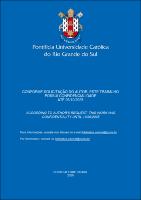| Share record |


|
Please use this identifier to cite or link to this item:
https://tede2.pucrs.br/tede2/handle/tede/9289| Document type: | Tese |
| Title: | Avaliação da atividade antitumoral e do perfil toxicológico do composto CPBMF-223 em experimentos in vitro e in vivo |
| Author: | Sperotto , Nathalia Denise de Moura  |
| Advisor: | Basso , Luiz Augusto |
| First advisor-co: | Rodrigues Junior , Valnês da Silva |
| Abstract (native): | A timidina fosforilase humana (hTP) é uma enzima responsável por catalisar a fosforólise de timidina em timina e 2-deoxi-D-ribose-1-fosfato, sendo altamente expressa em diversos tumores sólidos, incluindo glioblastoma e carcinoma colorretal. O presente trabalho teve como objetivo investigar o perfil toxicológico e farmacológico do composto CPBMF-223 – um potente inibidor não competitivo da hTP –, em modelo animal de glioblastoma e de carcinoma colorretal. Para a avaliação da toxicidade do CPBMF-223, foram realizados estudos in vitro de citotoxicidade (25 - 1000 μM), genotoxicidade (250 - 1000 μM) e mutagênese (100 - 2000 μg/placa). Além disso, foram investigados os efeitos em parâmetros de cardiotoxicidade e neurotoxicidade em larvas de peixe-zebra (50 - 500 μM), assim como no ensaio de toxicidade oral em camundongos (300 e 2000 mg/kg). O perfil farmacocinético do inibidor da hTP foi analisado pelas vias intravenosa (i.v.), intraperitoneal (i.p.) e oral, bem como a capacidade de ligação a proteína plasmática. Os efeitos farmacológicos do CPBMF-223, (50 mg/kg/dia, 5 dias/semana) foram obervados sobre o crescimento tumoral no modelo xenográficos induzido por células humanas de glioblastoma (U-87 MG) e de câncer de colorretal (HCT-116) em camundongos nude (machos e fêmeas). De maneira interessante, os resultados mostram que o CPBMF-223 não induziu citotoxicidade, além de não apresentar efeitos genotóxicos e mutagênicos. Não foi observado alterações significativas na toxicidade aguda em roedores, e mostrou baixo perfil tóxico em modelo de peixe-zebra. O CPBMF-223 demonstrou uma alta biodisponibilidade (>100%) quando administrado pela via i.p., e baixa ligação a proteína plasmática (34%). Notavelmente, o inibidor da hTP foi capaz de reduzir o volume relativo do tumor e a taxa de crescimento tumoral, em ambos os modelos experimentais. No modelo de glioblastoma, a taxa de inibição foi de 31% em camundongos machos, e de 50% no modelo experimental de colorretal. Para as fêmeas, houve uma redução de 50% no modelo in vivo de câncer de colorretal. Interessantemente, em ambos os modelos animais, o CPBMF-223 foi capaz de diminuir o número de vasos sanguíneos presente nos tumores e não modificou enzimas preditoras de lesão hepática. Coletivamente, os resultados trazem novas evidências da segurança toxicológica do composto CPBMF-223 e da atividade antitumoral desempenhada em modelos in vivo de câncer, apontando esse inibidor como um promissor fármaco no tratamento de cânceres. |
| Abstract (english): | Human thymidine phosphorylase (hTP) is an enzyme responsible for catalizing the phosphorolysis of thymidine in thymine and 2-deoxy-D-ribose-1-phosphate, being overexpressed in several solid tumors, including glioblastoma and colorectal carcinoma. The present study aimed to investigate the toxicological and pharmacological profiles of CPBMF-223 compound - a potent noncompetitive hTP inhibitor -, in a glioblastoma and colorectal carcinoma animal models. To evaluate the toxicity of CPBMF-223, in vitro assays of cytotoxicity (25 – 1000 μM), genotoxicity (250 – 1000 μM) and mutagenesis (100 – 2000 μg/plate) were performed. In addition, the cardiotoxicity and neurotoxicity effects were assessed in zebrafish larvae (50 – 500 μM), as well as the acute oral toxicity in mice (300 and 2000 mg/kg). The pharmacokinetic profile of the hTP inhibitor was analysed by intravenous (i.v.), intraperitoneal (i.p.), and oral as well as the plasma protein binding capacity. The pharmacological effects of CPBMF-223 (50 mg/kg, 5 days/week) were observed on the tumor growth in the xenographic model induced by human glioblastoma cells (U-87 MG) and human colorectal cancer (HCT-116) in nude mice (female and male). Interestingly, the results showed that CPBMF-223 did not induce cytotoxicity, genotoxicity and mutagenic effects. Moreveover, no significant changes was noted in acute toxicity experiments, with a slightly low toxic profile in the zebrafish model. CPBMF-223 also demonstrated a high bioavailaibity (>100%) in i.p. administration and low plasma protein binding (34%). Notably, the hTP inhibitor was able to reduce the relative tumor volume and the tumor growth rate, in both experimental models. In the glioblastoma model, the inhibition rate was 31% in male mice, and 50% in the colorectal model. For female, the percentage of reduction was 50% in the colorectal model. Interestingly, in both in vivo models, CPBMF-223 was able to decrease the tumors number of blood vesses and did not modify the liver injury enzymes. Collectively, the resuts bring new evidence of the toxicological safety of the CPBMF-223 compound and the antitumor activity performed in in vivo cancer models, pointing out this inhibitor as a promising drug to cancer treatment. |
| Keywords: | Timidina fosforilase humana CPBMF-223 Glioblastoma Câncer colorretal Camundongos nude Modelo xenográfico Human thymidine phophorylase CPBMF-223 Glioblastoma Colorectal cancer Nude mice Xenogaft cancer model |
| CNPQ Knowledge Areas: | CIENCIAS DA SAUDE::MEDICINA |
| Language: | por |
| Country: | Brasil |
| Publisher: | Pontifícia Universidade Católica do Rio Grande do Sul |
| Institution Acronym: | PUCRS |
| Department: | Escola de Medicina |
| Program: | Programa de Pós-Graduação em Medicina e Ciências da Saúde |
| Access type: | Acesso Aberto |
| Fulltext access restriction: | Trabalho será publicado como artigo ou livro |
| Time to release fulltext: | 60 meses |
| Date to release fulltext: | 26/10/2025 |
| URI: | http://tede2.pucrs.br/tede2/handle/tede/9289 |
| Issue Date: | 27-Mar-2020 |
| Appears in Collections: | Programa de Pós-Graduação em Medicina e Ciências da Saúde |
Files in This Item:
| File | Description | Size | Format | |
|---|---|---|---|---|
| TES_NATHALIA_DENISE_DE_MOURA_SPEROTTO_CONFIDENCIAL.pdf | NATHALIA_DENISE_DE_MOURA_SPEROTTO_TES | 439.11 kB | Adobe PDF |  Download/Open Preview |
Items in DSpace are protected by copyright, with all rights reserved, unless otherwise indicated.




